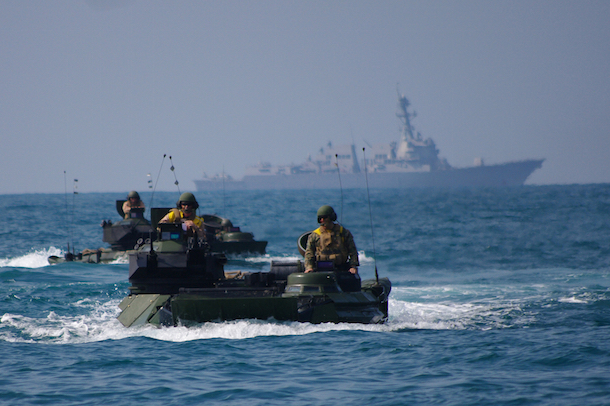
The Case for ASEAN Military Integration
While Southeast Asia considers closer military integration, China continues its encroachment on the sovereignty of the region. The Association of Southeast Asian Nations has the potential to become a fully integrated mutual defense alliance which stands to ward off aggressive acts from an increasingly southward expanding PRC. This process of military and security integration has already begun in the form of the ASEAN Chiefs of Defense Forces Informal Meetings and ASEAN Defense Ministers Meetings. These meetings provide a forum for the nations to discuss their pressing security issues in a collaborative setting. External threats provide the perfect environment for internal cooperation and this region collectively faces a unilateral threat from an aggressive China.
Why would the states favor military integration? Military cooperation in the form of a collective security organization would allow the region to assert their territorial claims to the South China Sea in lieu of China’s. This goal itself poses fundamental problems to the very idea of cooperation by ASEAN members. China only represents one of the countless territorial claimants over the South China Sea. Most claimants are ASEAN members and would represent competing interests within the alliance. These competing interests do pose challenges to the prospect of cooperation but are possible to overcome through analyzing the ranking of each states preferable outcomes.
The South China Sea currently entertains claims or partial claims from Indonesia, China, Taiwan, Vietnam, the Philippines, Malaysia, Cambodia, Thailand, and Singapore. Of these states only one, China, is a great power capable of truly global power projection. Every other state with competing claims actually lacks the military capacity to dispute any of China’s claims.
This single truism means that the only hope for keeping China out of the region will require balancing and collaboration by the smaller powers.
Now certainly not all claims and disputes over borders are with China, meaning that some states in the region have no direct quarrel with the PRC, but that does not mean their interests are not threatened by Chinese presence in the region.
Since the days of the Srivijaya (ancient kingdom based on Sumatra) and the Spice Islands, Southeast Asia has been a pillar of international trade, whether consensual or otherwise. This international trade finally stands to benefit the population of the region in place of the frequently exploitative system that has been forced upon the region for centuries. Though this trade system is threatened if the People’s Republic of China continues to force its presence into strategic waterways.
Would ASEAN military cooperation be sufficient to deter further Chinese encroachment? According to the Stockholm International Peace Research Institute Military Expenditure Database, the total military expenditures of ASEAN in 2013 equal around $38 billion USD. This is miniscule compared to China’s 2013 expenditures of $188 billion USD but represents a unified threat that could be substantial in deterring China from aggressive action. (SIPRI) Currently the cost of China taking aggressive or hostile postures towards individual countries with which it has disputes is effectively zero. No single nation in the region even poses a threat of military resistance due to the imbalance of power. But a unified front with shared military resources of approximately a fifth of China’s expenditures would pose a serious threat to uncontested Chinese hegemony in the region. Unilaterally attacking such an alliance would surely make China a pariah in the international system. Military cooperation between ASEAN states would not be for the purpose of fighting China, but would serve to negotiate from a position of strength and not the current climate of weakness.

Such an alliance of Southeast Asian states was tried before and with spectacular failure. The Southeast Asian Treaty Organization previously existed to prevent the spread of communism in the region. SEATO was hardly a collective security organization but a tool for American policy interests. It was not intended for sovereignty and security but an effort by the U.S. to contain states that did not recognize American hegemony. The failures of the past can become the roadmap for future cooperation. While SEATO stood directly opposed to communist states, ASEAN military cooperation should be based on common regional threats and not the domestic composition of states. This will be critical in maintaining the cooperation of member-states as Southeast Asia is host to a number of different regime types, ranging from single party communist states, functioning democracies, military dictatorships, and theocratic monarchies.
How would China respond to such an aggressive alignment against its interests? With China’s increasing look towards the Middle East as postulated in the New Silk Road theory, coercion will have to be replaced with cooperation. The modern or maritime Silk Road theory argues China’s foreign policy is wholeheartedly devoted towards opening ports in the Indian ocean to connect the oil-rich near east with China, requiring shipping lanes through the South China sea and a compliant, passive, and cooperative Southeast Asia. At this point in time and for the foreseeable future China does not have the potential to risk truly aggressive relations with ASEAN nations due to the international costs of acting outside of the international order. Currently, bullying the individual-minded Southeast Asian nations has no cost and will not escalate to war due to the sheer scale of asymmetry within each China – Southeast Asia dyad. By raising the costs China would have to pay if war broke out above their current negligible levels, Southeast Asia can actually assert itself and negotiate solutions that are not excessively one sided and reflect the true power of the region.
Other instances that could benefit from collective security alliances to ward off aggressive great powers include the former eastern bloc countries. Had NATO not so callously and incredibly commit to the defense of former Warsaw Pact countries, the region could have used the opportunity to realign into an anti-Russian collective security agreement. This commitment would have been much more credible because an attack on one former Warsaw Pact member does serve as a threat to the other members. This same logic is true in Southeast Asia, China’s aggression towards one ASEAN member serves as a threat to the prosperity of all ASEAN members.
Surely military cooperation among ASEAN states could also provide a platform and opportunity for outside assistance that does not currently exist among the fragmented status quo. If India wished to push back and maintain its influence in the Indian Ocean, one method would be to pledge its support for the ASEAN alliance. This provides the ASEAN alliance with much needed naval power, a resource surprisingly lacking in a region so tied to maritime control. India has incentives to check China’s Silk Road initiative, which is heavily dependent on Chinese ties to Pakistan. The prospects of a rising state and future great power like India declaring for a quickly assembled alliance seem unlikely, but represents a potential wedge for India to rise in power relative to China. India has already made advances towards relations with ASEAN as a whole, engaging in free trade with them. Security and defense ties between the two partners have also increased a sign of further cooperation to come.
One must also not ignore the political difficulty of cooperation between ASEAN states. Each state in the region has competing internal goals that make accomplishing external goals difficult. Just related to the South China Sea, the competing claims are often not against China but other ASEAN members. This issue can be resolved with the simple maxim that if ASEAN members do not cooperate they will lose all current claims to China. It is a simple case of ordered preferences where it appears that all states prefer China to stay out of the region, to China in the region and would prefer a world in which their goals are not achieved but China stays out. This ranking of preferences forces cooperation and prevents cheaters from attempting to break the alliance in order to strike a deal with China.
Southeast Asia has historically found itself at the crossroads of southern and eastern Asian identities. The 21st century provides an opportunity for the region to define itself anew and assert its role in the international system. This opportunity will not be possible if China is not stopped, an achievement only conceivable through cooperation and outside resources. China is currently trying to bring ASEAN states to the table to settle their differences, but any solution reached at this time will favor China. In order to defend the region and their interests, military cooperation is a necessity.

